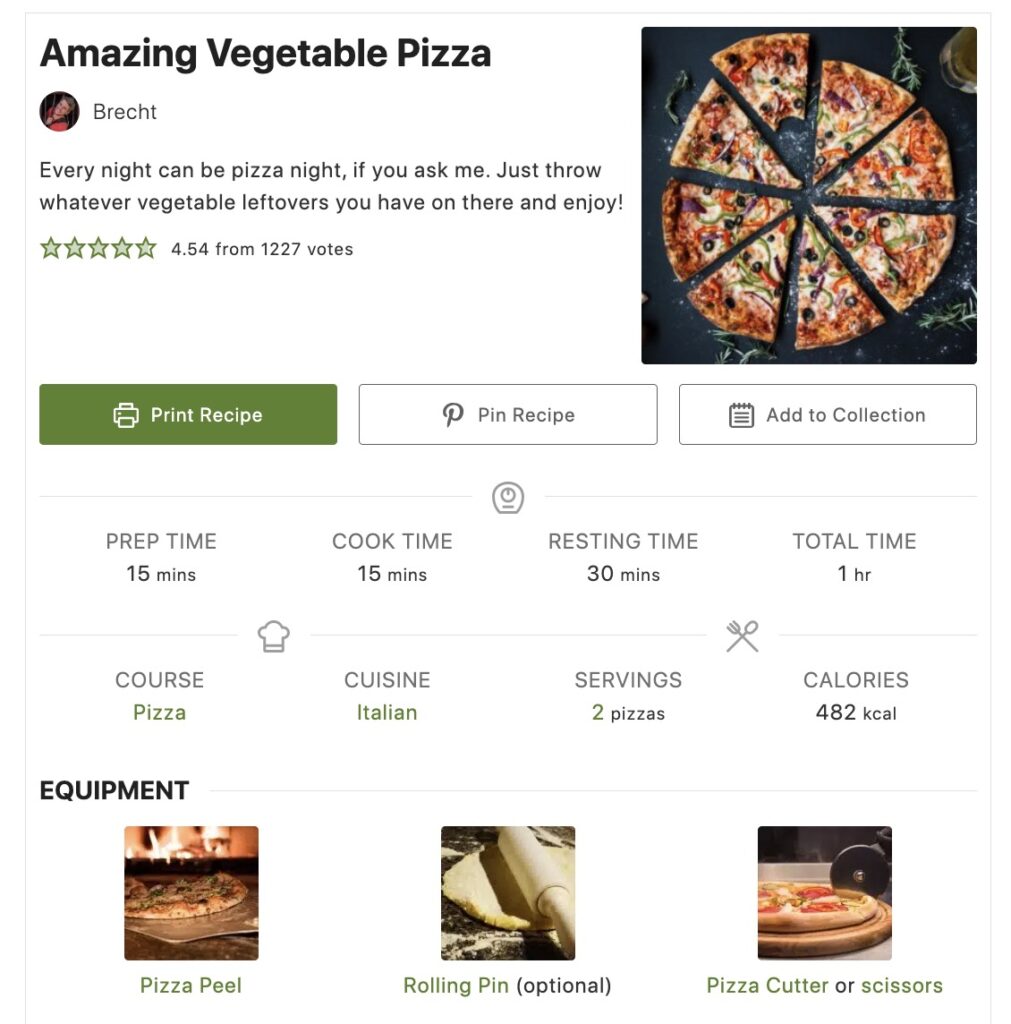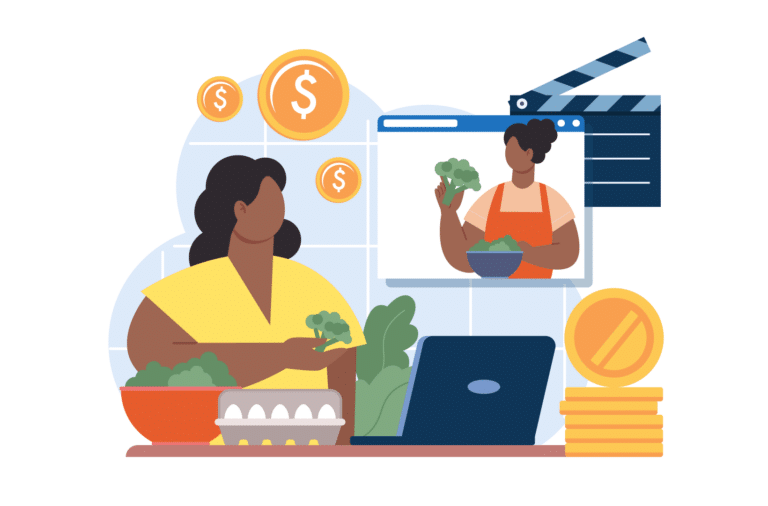Looking to propel your food business into the limelight and drive sales to new heights?
This guide holds the keys to unlocking the full potential of food digital marketing. We explain why digital marketing matters and take you through the top 6 digital marketing tactics and tools – from social media marketing to SEO-friendly food blogging, and more.
Keep reading to learn how to navigate current trends, capture the attention of your audience group, and drive conversions.
The power of digital marketing in the food industry
For all the things that differentiate members of the human race, there is one thing that unites us: we eat and drink. This means that people will inevitably be on the hunt for new food brands, whether that’s restaurants or food products.
This means that people are largely receptive to being exposed to such brands, and as the owner or marketer of a food brand, you should use that to your advantage and develop a solid digital marketing strategy that can help you stand out from the crowd and drive sales.
In today’s age, this largely means content. This could mean SEO-focused content marketing via blog posts that share recipes and showcase new products, which increases the chance of people finding your website when they search for specific topics and terms.
Social media platforms like Instagram, TikTok, Twitter/X and Pinterest are ideal for leveraging food trends and engaging with followers. For example, burrito brand Chipotle illustrated this when it briefly renamed itself “Chicotle” on X (formerly Twitter), instantly winning the heart of BTS’s fanbase ARMY.

Social media can also open the door to collaboration opportunities with influencers. By partnering with food enthusiasts or nutrition experts, brands can add credibility and reach out to new audience groups, such as hummus brand Sabra partnering with one of the most popular TikTok users, Charli D’Amelio, to leverage her 151 million followers.
Both social media platforms such as Instagram and TikTok, as well as platforms like YouTube are highly centered around video content, with an audience reach of 92% worldwide. As such, food brands can’t afford to miss the benefits of video marketing.
6 key tips for growing your audience through digital marketing
1. Capitalize on social media
Just as foodies keep their eyes peeled on social media for new experiences, it’s essential for food and beverage businesses to build their presence on social media platforms as well as monitor current digital trends for new content inspirations.
Social media trends come in different shapes, but most platforms, including TikTok and Instagram, use specific keywords or hashtags to increase visibility. Food brands can make the most of the unique tools and advantages of each social media platform and increase their reach:
- Visual appeal in food and beverage marketing: People love to feast with their eyes. Visual content on social media, especially for food and drinks, packs a punch in terms of capturing attention. Brands and bloggers can showcase their culinary creations on social media platforms and let the visuals speak for them.
- Instagram hashtag magic: Instagram, with its visually-driven format and storytelling, is a goldmine for food businesses. You can harness the power of Instagram hashtags to tap into trending topics. The platform tools can elevate your content and make it more discoverable to a wide audience demographic.
- YouTube engaging potential: YouTube, another visual-centric platform, provides a robust space for content engagement. For content creators, this is the opportunity to create food videos that showcase recipes, show behind-the-scenes glimpses, or even introduce collaborations.
- Direct traffic back to your core site: While social media is a fantastic stage for brand awareness and audience growth, the priority is to guide your followers to your website or food blog. This will help convert viewers into customers.
2. Build a high-quality website
A quality website fulfills multiple purposes for your audience. It acts as a virtual store, an information hub, and a direct line of communication.
Your website’s content should support and back up your marketing initiatives. Whether it is a product launch, an exciting recipe, or the brand’s story, your content becomes a magnet that can pull your audience in.
Moreover, you need an SEO-friendly website to boost organic traffic. An SEO-optimized site is more likely to be highly visible in search results when your audience is looking for relevant keywords.
“Getting your website right is crucial because it needs to represent your brand – not just in the information you display but also the way you present it, from the colors and graphics to the customer experience. As such, you’ll need to think about the functionality you need for this, from utilizing gallery sliders for displaying new products above the fold, to stylized forms in your Contact page.”
Birthe VandermeerenCofounder of Bootstrapped Ventures
For food brands, a feature that is really useful is the ability to display recipes. If you own a restaurant, you can showcase some sample dishes from the menu; if you sell food equipment, ingredients, and food products, then you can inspire creativity on how these can be used.
For WordPress sites, WP Recipe Maker is the ideal plugin for displaying recipes via highly customizable recipe cards that can be included on blog posts and pages. It is a favorite plugin among food influencers for their food blogs thanks to its built-in SEO features, user-friendly interface, and excellent monetization functions.

There are numerous ways you can get creative with WP Recipe Maker. For example, if you sell a blender, you can showcase a recipe made using the product and include links to the product page within the recipe itself via the equipment links feature. This allows you to showcase the value of your product and create direct conversion points.

3. Add a blog to your website
A food blog is another crucial element for maintaining a comprehensive online presence. Your blog acts as a dynamic platform for real-time product updates while also keeping your brand story alive with a variety of content updates. Blogs promote continual engagement, keeping potential customers interested and coming back for more.
Additionally, your blog makes it easier to link different content pieces, so your website is constantly evolving. It becomes a knowledge hub, linking together diverse content in a cohesive manner and effectively catching your target audience’s interest and loyalty.
With WP Recipe Maker, you can use your blog to share aesthetically pleasing recipes to highlight the value of your services or products.
Customizable templates with different placement options for photos, links, ingredient lists, ads, and more, enable bloggers to design a unique look and feel. The tool also comes with a set of specialized tailoring features you can use to enhance food content, including adjustable serving sizes on recipes.
Finally, there’s more to the food blog than meets the eye. It is a strategic tool that drives your SEO strategy and can increase organic traffic. By incorporating carefully researched and relevant keywords, you can tackle emerging trends.
You can also boost technical SEO through a mobile-responsive display for all new content pieces and dedicated geo-tags and location-based filters where relevant. WP Recipe Maker further enhances technical SEO through metadata functionality for recipes.
4. Employ food delivery apps
Following the COVID-19 pandemic, the adoption of food delivery apps has become a norm, with people relying more and more on these platforms to conveniently order food straight to their homes. For food and beverage brands, here’s why it makes sense to integrate delivery apps as part of your digital marketing plan in an effort to stay relevant and meet the growing needs of your audience:
- Changing consumer behaviors: The pandemic accelerated the shift in consumer behaviors. The ease and safety of ordering from home make these apps a go-to preference.
- Optimize content for impact: Content is king, even on food apps. But your aim is conciseness with short, clear, and punchy descriptions along with high-quality images of your products. Visual appeal with authentic images helps to differentiate your brand in a crowded marketplace.
- Maximize visibility: Food apps have a range of options to increase your brand visibility, including promotional displays, special offers, coupon collections, and featured listings that can ensure potential customers will notice you.
- Seamless ordering experience: The last thing customers need is to struggle when they are trying to order. This is why you want to streamline menus, provide accurate dish descriptions, and offer user-friendly payment options to create a seamless ordering experience following eCommerce principles.
5. Influencer marketing
Influencer marketing has opened the doorway to impactful partnerships where influencers share their experiences with your brand, effectively acting as brand ambassadors.
Influencers are often viewed as relatable figures by their followers, and as their popularity soars, they present a valuable marketing opportunity, especially to promote your restaurant or products to a bigger audience.
Selecting influencers whose audience aligns with your target market is crucial. Synergy ensures authenticity, a key element in influencer marketing success. For example, if you’re trying to promote a very spicy hot sauce, you probably don’t want to reach out to an influencer known for their intricate desserts.
Bear in mind that Influencer marketing isn’t limited to traditional endorsements. It is worth exploring creative content avenues, such as recipe tests, cooking tutorials, etc. Diversifying your content keeps the audience engaged and introduces your brand in various contexts.
Ultimately, influencer marketing is about creating authentic connections with potential buyers through trusted voices. By strategically collaborating with influencers whose values align with your brand, you open doors to a wider audience, creating a ripple effect of interest and engagement.
6. Integrate different kinds of content into your campaigns
Digital preferences are constantly evolving, which means you need to keep adapting your content marketing to align with changing technologies and needs. Currently, video content is highly popular, boasting high engagement rates and a high ROI.
Video content comes in various forms, each offering a unique opportunity to engage your audience. Consider incorporating product videos, demonstrations, or enticing recipe videos into your marketing arsenal. These formats provide a visual and dynamic way to showcase your offerings, creating a more immersive experience for viewers.
While video content is a powerful tool, its impact hinges on quality. High-quality videos not only captivate your audience but also reflect positively on your brand. It is essential to keep it consistent with the values and tone of your brand to create a cohesive and authentic visual narrative.
Diversifying your content marketing strategy to include various formats, including video, podcasts, ebooks, etc., opens doors to engage a broader audience. It also allows for greater accessibility across different platforms. Essentially, a diverse content mix ensures your brand remains dynamic and resonates with a diverse range of viewers.
Drive success for your food brand with effective digital marketing
From building a high-quality website to leveraging social media trends, employing food delivery apps, and embracing influencer marketing, a food brand’s marketing journey involves a strategic blend of tactics.
One standout tool that adds significant value to the digital marketing arsenal, especially for WordPress users, is WP Recipe Maker. This versatile plugin facilitates the seamless display of recipes on your website, offering highly customizable recipe cards that make it easy to showcase the value of your products, ingredients, or services.
Its user-friendly interface, built-in SEO features, and effective monetization functions make it a favorite among food influencers and brands alike. Don’t miss the opportunity to enhance your online presence and captivate your audience – consider incorporating WP Recipe Maker into your digital strategy today!







